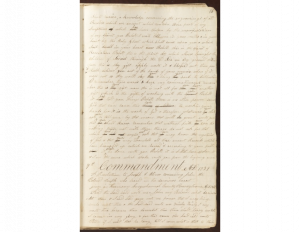Historical Context and Background of D&C 7

Video Overview
Brief Synopsis by Steven C. Harper
In the spring of 1829, as they translated and scribed the Book of Mormon, nothing excited the young seers Joseph and Oliver more than the idea of sacred ancient writings that had not yet come to light. The Book of Mormon was not just the best example of this; it mentioned many other texts. The Lord told Oliver in section 6 that he could, like Joseph, translate records like these if he desired.1
As they translated, they discussed John 21:20–23. What did the words “that that disciple should not die” mean? Was John still alive? The text itself is ambiguous. Bible scholars had been “puzzled with this passage,” and Joseph and Oliver couldn’t agree on its meaning.2 They agreed to seek clarifying revelation through the seer stones Joseph used to translate the Book of Mormon. There they saw a parchment John had written and hidden.3
The parchment was apparently the original source for the Gospel of John in the New Testament. The revelation of the parchment to Joseph and Oliver restored much that was lost from the final few verses of John 21. The Lord did give John power. As the revelation was originally recorded, this was power to bring souls to Christ. When Joseph reviewed the revelations for publication in 1835, he clarified that John asked the Lord for “power over death, that I may live and bring souls to thee.”4 The Lord granted John’s desire. Joseph also added to the 1835 Doctrine and Covenants the words in verses 6–7. The Lord said of John, “I will make him as flaming fire and a ministering angel: he shall minister for those who shall be heirs of salvation who dwell on the earth.” The Lord said to Peter, “And I will make thee to minister for him and for thy brother James: and unto you three I will give this power and the keys of this ministry until I come.”5
This section clarified an ambiguous Bible passage and satisfied Joseph and Oliver’s curiosity. It did more work than that, however. It restored to the scriptures the fact that Jesus gave keys of salvation to Peter, James, and John. The revelation confirmed both that the Bible is true and that the Bible is not complete, nor is it sufficient for salvation. We don’t just have the incomplete records of dead apostles. Jesus Christ sent Peter, James, and John back to earth to confer their keys on Joseph Smith and Oliver Cowdery not too long after they received this revelation.
The modern apostle Boyd K. Packer stood with President Spencer W. Kimball, other apostles, and local church leaders in the Church of Our Lady in Copenhagen, Denmark, admiring Thorvaldsen’s Christus and his sculptures of the twelve apostles. Peter holds symbolic keys in his hand, given him by Jesus Christ. President Kimball pointed them out and then charged the Copenhagen stake president to “tell every prelate in Denmark that they do not hold the keys. I hold the keys!” As the party left the church, President Kimball shook hands with the caretaker, “expressed his appreciation, and explained earnestly, ‘These statues are of dead apostles.’” He then said, “You are in the presence of living apostles.”6
1. “Revelation, April 1829–A [D&C 6],” The Joseph Smith Papers, accessed July 22, 2020.
2. Adam Clarke, The New Testament of Our Lord and Saviour Jesus Christ. The Text Carefully Printed from the Most Correct Copies of the Present Authorised Version, Including the Marginal Readings and Parallel Texts… Vol. 1 (New York: J. Emory and B. Waugh, 1831), 631.
3. “Account of John, April 1829–C [D&C 7],” The Joseph Smith Papers, accessed July 22, 2020.
4. 1835 Doctrine & Covenants 33:1 (D&C 7:2).
5. “Doctrine and Covenants, 1835,” p. 161, The Joseph Smith Papers, accessed July 22, 2020.
6. Boyd K. Packer, The Holy Temple (1980), 83. Edward L. Kimball, Lengthen Your Stride: The Presidency of Spencer W. Kimball (Salt Lake City: Deseret, 2005), 108, 327.
Additional Context by Casey Paul Griffiths
From Doctrine and Covenants Minute
Joseph and Oliver began translating the Book of Mormon on April 7, 1829. During this time their friendship continued to grow, and they engaged in a number of lively discussions about the translation. According to Joseph’s history, “A difference of opinion [arose] between us about the account of John the Apostle, mentioned in the New Testament, John, twenty first chapter and twenty second verse, whether he died, or whether he continued; we mutually agreed to settle it by the Urim and Thummim” (History, 1838–1856, vol. A-1, 15). It is possible this question arose because of their translation of the Book of Mormon text, specifically where the book describes both Alma and Moses as being “taken up by the spirit, or buried by the hand of the Lord” (Alma 45:19).
The introduction in the 1833 Book of Commandments describes the revelation as “translated from parchment, written and hid up by himself” (Book of Commandments, 1833, 18). While there is no known parchment associated with translation, the parchment described may have been seen through one of the instruments used in translation. One witness of the translation process said that in the translation instruments “a piece of something resembling parchment would appear, and on that appeared the writing” (David Whitmer, Address to All Believers in Christ, 1886, 12). This revelation is the beginning of the fulfillment of the Lord’s promise to Oliver that he would “assist in bringing to light . . . those parts of my scriptures which have been hidden because of iniquity” (D&C 6:27).
See Historical Introduction, “Account of John, April 1829–C [D&C 7],” p. 13, The Joseph Smith Papers, accessed September 23, 2020, https://www.josephsmithpapers.org/paper-summary/account-of-john-april-1829-c-dc-7/1
